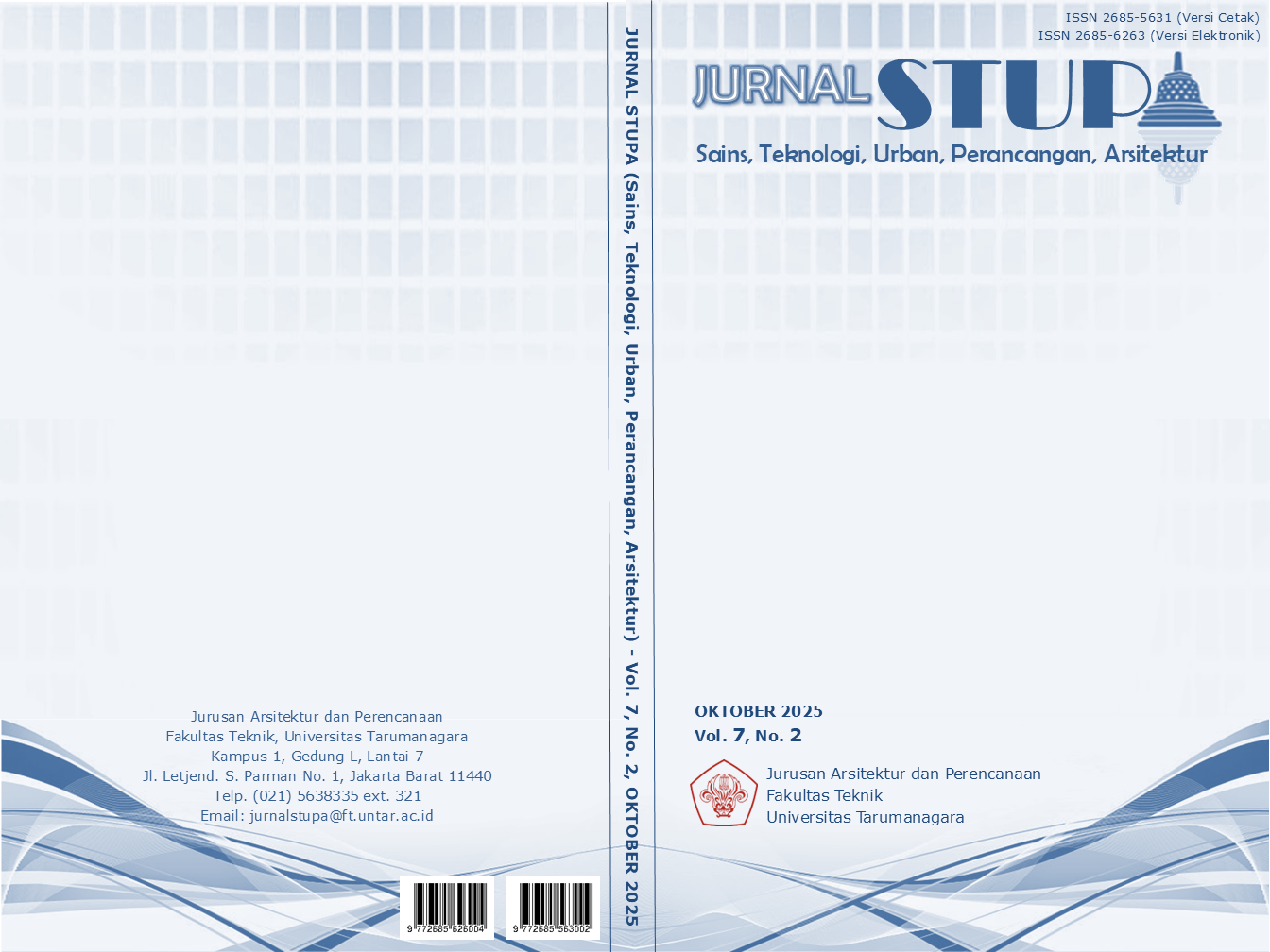PENDEKATAN ARSITEKTUR BIOMIMIKRI TERHADAP BALE PRANA DI KELURAHAN KEBON SIRIH
Main Article Content
Abstract
The phenomenon of air pollution in Jakarta has reached a critical point, marked by the city being recorded as having the highest Air Quality Index (AQI) in the world on August 13, 2024. The concentration of fine particulate matter (PM2.5), exceeding the World Health Organization's (WHO) safe threshold, has led to a significant increase in cases of Acute Respiratory Infections (ARI), especially in densely populated urban areas. Unfortunately, architectural responses to this crisis remain limited, particularly in designing spaces that support respiratory health. This research proposes an alternative approach through the integration of biomimicry architecture and the use of betel leaf (Piper betle) and golden pothos (Epipremnum aureum), which are known for their bioactive compounds and natural ability to absorb air pollutants. The study focuses on Bale Prana, a prototype of an urban therapy space that combines betel leaf cultivation, natural ARI remedies, preservation of traditional knowledge, and the strengthening of healthy urban communities. The research methodology adopts a descriptive qualitative approach through literature studies and architectural design exploration based on biomimicry principles. The process includes problem identification, in-depth study of the characteristics of betel plants, and the application of these findings in the design of the building façade. The result of this research is a biomimetic façade concept that functions not only as an aesthetic element but also as an ecological device for filtering air and supporting natural respiratory healing. The findings highlight the potential of transforming plant structures and biological materials into architectural solutions that adapt to the challenges of urban environmental crises.
Keywords: betel; biomimetic; biomimicry; facade
Abstrak
Fenomena polusi udara di Jakarta telah mencapai titik kritis, ditandai dengan ditetapkannya kota ini sebagai pemilik Indeks Kualitas Udara (AQI) tertinggi di dunia pada 13 Agustus 2024. Kadar partikulat halus (PM2.5) yang melebihi ambang batas aman WHO menyebabkan lonjakan signifikan pada kasus Infeksi Saluran Pernapasan Akut (ISPA), terutama di wilayah urban padat penduduk. Sayangnya, respons arsitektural terhadap krisis ini masih minim, terutama dalam merancang ruang yang mendukung kesehatan pernapasan masyarakat. Penelitian ini menawarkan pendekatan alternatif melalui integrasi arsitektur biomimikri dengan pemanfaatan tanaman sirih (Piper betle) dan sirih gading (Epipremnum aureum) yang dikenal memiliki senyawa bioaktif serta kemampuan menyerap polutan udara secara alami. Studi ini berfokus pada Bale Prana, sebuah prototipe ruang terapi urban yang menyatukan pertanian sirih, pengobatan alami ISPA, pelestarian pengetahuan tradisional, dan penguatan komunitas sehat. Metode penelitian yang digunakan adalah pendekatan kualitatif deskriptif melalui studi literatur serta eksplorasi desain arsitektural berbasis biomimikri. Prosesnya meliputi identifikasi masalah, pengkajian mendalam mengenai karakteristik tanaman sirih, serta penerapan hasil kajian dalam perancangan fasad bangunan. Hasil akhir penelitian ini adalah konsep fasad biomimetik yang tidak hanya berfungsi sebagai elemen estetis, tetapi juga memiliki peran ekologis dalam menyaring udara serta mendukung pemulihan kesehatan pernapasan secara alami. Temuan ini menunjukkan potensi transformasi material hayati dan struktur tanaman menjadi solusi arsitektural yang adaptif terhadap krisis lingkungan urban.
Article Details

This work is licensed under a Creative Commons Attribution-NonCommercial-ShareAlike 4.0 International License.
This work is licensed under a Jurnal Sains, Teknologi, Urban, Perancangan, Arsitektur/ STUPA Creative Commons Attribution-NonCommercial-ShareAlike 4.0 International LicenseReferences
Akbar, Z., Renaldi, R., Dewi, O., Rany, N., & Hamid, A. (2023). Perilaku Pencegahan ISPA di Wilayah Kerja Puskesmas Bunut Kabupaten Pelalawan. JURNAL KESEHATAN KOMUNITAS, 12-20.
Benyus, J. (1997). Biomimicry: Innovation Inspired by Nature. New York: William Morrow.
Corbusier, L. (t.thn.). Towards a New Architecture. 1923.
Cotton, C. (1996). Ethnobotany: Principles and Applications.
Frampton, K. (1983). Towards a Critical Regionalism.
Haq, A. D., Rahiem, A. R., & Rahayu, L. A. (2021). POTENSI SIRIH GADING (Epipremnum aureum) DAN LILI PARIS (Chlorophytum comosum) SEBAGAI SARANA FITROMEDIASI PM2.5 DI DALAM RUANGAN. Jurnal Kedokteran, 10(1), 347-354.
Hulu, L. C., Fau, A., & Sarumaha, M. (2022). PEMANFAATAN DAUN SIRIH HIJAU (Piper Betle L) SEBAGAI OBAT TRADISIONAL DI KECAMATAN LAHUSA. TUNAS: Jurnal Pendidikan Biologi.
Iano, J., & Allen, E. (2014). Fundamentals of Building Construction.
Kurokawa, K. (1997). Each One a Hero: The Philosophy of Symbiosis.
Novianti, T. (2017). Identifikasi Unidentified Gen Sitoglobin Dengan Desain Primer Multiple Alignment Dan qPCR mRNA Pada Proses Regenerasi Jaringan Ekor Cicak. Universitas Esa Unggul.
Pawlyn, M. (2011). Biomimicry in Architecture.
Polo, A. Z. (2008). The Politics of the Envelope.
Rahyuni, Ynianti, E., & Pitopang, R. (2013). KAJIAN ETNOBOTANI TUMBUHAN RITUAL SUKU TAJIO DI DESA KASIMBAR KABUPATEN PARIGI MOUTONG. Online Jurnal of Natural Science, 46-54.
Silalahi, M. (2020). Ethnobotany of the Mountain Regions of Southeast Asia. Springer. doi:https://doi.org/10.1007/978-3-030-14116-5_92-1
Vincent, J. F., Bogatyreva, O. A., N. R., Bowyer, A., & Pahl, A. K. (2006). Biomimetics: its practice and theory.
Yusran, S., Bahar, H., Ekayanti, D., Pahruddin, H. A., & Salfina. (2024, June). PENYULUHAN ISPA (INFEKSI SALURAN PERNAPASAN AKUT) PADA MASYARAKAT DESA WATUNGGARANDU KECAMATAN LALONGGASUMEETO KABUPATEN KONAWE TAHUN 2024. Lontara Abdimas, 5(1), 23-30.



